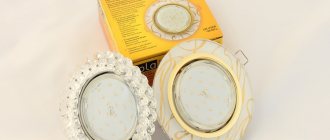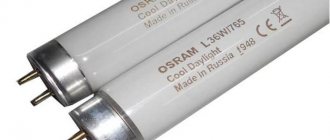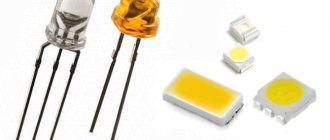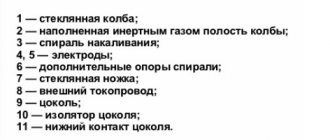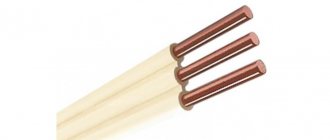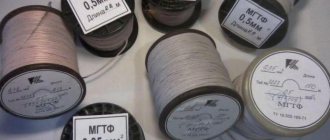To decipher the designations of lamps according to GOST 17677, this data may be useful to you. You can now easily find out what housing and communal services, health care facilities, health care facilities, non-governmental organizations, scientific and industrial enterprises, rural public utilities or state public utilities are.
By the first letter we will determine the light source, by the second - the installation method, and by the third - the main purpose.
For example, the decoding of housing and communal services means: sodium console, end lamp for outdoor lighting. In the same way, we can find out what a LPO : a linear fluorescent ceiling lamp for public buildings ( LPU is the same, but not for public buildings, but for outdoor lighting). Explanation of NPP : ceiling lamp for industrial and industrial buildings with a general-purpose incandescent lamp. Abbreviation RKU : mercury ( DRL ) console, end lamp for outdoor lighting. NPO : ceiling lamp for public buildings with a general purpose incandescent lamp.
Such alphanumeric abbreviations (for example LPO 2x40) carry detailed information about the characteristics of the lamp and its classification. In the symbol of a lamp, each position indicates its own characteristic.
Classification of lamps is carried out according to the following criteria:
- by type of light source used;
- by installation method;
- for its main purpose;
- according to climatic design;
- by accommodation category.
Let's look at the example of NPO-50 2x40-010 U1:
| N | P | ABOUT - | 50 | 2 x | 40 — | 010 | U1 |
| 1 | 2 | 3 | 4 | 5 | 6 | 7 | 8 |
- Light source,
- Installation method
- Main purpose
- Two-digit series number,
- Number of lamps
- Lamp power (W),
- Three-digit modification number,
- Climatic modification and placement category.
Classification of lamps according to the type of light source used
| Light source | Legend |
| general purpose incandescent lamp | N |
| lamps (reflective and diffuse) | WITH |
| quartz halogen lamps | AND |
| linear fluorescent lamps | L |
| shaped fluorescent lamps | F |
| erythema fluorescent lamps | E |
| mercury lamps type DRL | R |
| mercury lamps type DRI, DRISH | G |
| sodium lamps type HPS | AND |
| germicidal lamps | B |
| xenon tube lamps | TO |
Scope of application
The LSP 2x36 luminaire is optimally suited for lighting basements, workshops, warehouses or industrial workshops. Due to the design features, the lamp can be used for kitchens, bathrooms, hospital wards, fire hazardous and wet areas. The design involves the use of tubular straight fluorescent lamps with a diameter of 36 mm (there are models for 32 mm and others), the optimal power is 40 W. Lamp type - LD40-2 or LB40-2.
Waterproof lamp LSP 2x36 for industrial facilities
Polycarbonate is usually used to make the structure, which increases strength and reduces weight, but for explosive and industrial workshops it is recommended to take lamps with metal bodies. UV-resistant polymethyl methacrylate is used for the diffusers; a layer of sealant is required between the diffuser and the body.
LSP pendant lamps are used:
- for premises with fire hazardous zones P-1, P-2, P-3;
- for areas with chemically active environments;
- for very humid, wet rooms, places with high dust levels.
For installation, you can use any convenient method, except for ceiling hangers. You can use fixation to the wall or tightly applied to ceilings (regular and suspended).
Classification of lamps by installation method
| Lamp type | Legend |
| suspension | WITH |
| ceiling | P |
| recessed | IN |
| attached | D |
| wall | B |
| tabletop, support | N |
| floor, crowning | T |
| cantilever, end | TO |
| manual | R |
| head | G |
LSP lamp: what is it, where is it used
To illuminate industrial facilities, devices of a wide variety of power and design are used. One of the most popular is a dust- and moisture-proof fluorescent lamp.
Compared to devices that use standard incandescent lamps, they provide almost the same level of illumination, but consume half as much electricity. The period of their operation is also longer - from 12 to 15 thousand hours of continuous operation.
The LSP lamp can be used both on the ceiling and on the walls. In production conditions, the second option is used quite often. Most often, the installation of such devices is indicated in rooms characterized by a high percentage of dust and moisture in the air.
Resistance to negative influence factors in lamps is achieved by tightly fixing its lampshade and base. It is provided with special clamps. In some models, seals are additionally used around the entire perimeter; they make the product completely airtight.
Such lamps are much more expensive; they are installed in workshops with a high content of dust particles in the air. Fluorescent lamps installed in such devices provide a uniform, bright glow of a sufficiently high level. The design of the device provides for the presence of a ballast. It is necessary to ignite the lamp and its subsequent stable combustion.
Manufacturers use various materials to make lampshades. Impact-resistant polymer glass, characterized by increased resistance to mechanical and physical stress, has proven itself best.
LSP lamps are rarely installed in living rooms; sometimes they can be found in offices. There, their use is quite acceptable, but only in combination with other lighting sources - E27 incandescent lamps or halogens. This minimizes the adverse effects of the fluorescent device on human vision.
The cost of LSP lamps is higher than standard lighting devices. But over time, the costs incurred are recouped by a noticeable reduction in electricity consumption. Lighting devices are produced with different numbers of lamps - from one to four. This allows them to be used at sites with different levels of required lighting: from production workshops to small warehouses.
Classification of lamps by main purpose
| Main purpose | Legend |
| for industrial and industrial buildings | P |
| for public buildings | ABOUT |
| for residential premises | B |
| for outdoor lighting | U |
| for mines and mines | R |
| for film and television studios | T |
Explanation of lamp markings
Requirements for lamps of all types are regulated by state standards. The document specifies quality and safety parameters for consumers, test and application conditions, as well as various technical parameters. GOST 17677-82 also determines the marking of lamps - an alphanumeric combination that must be present on each product. Decoding the designations gives the owner complete information about the properties and application of the lamps.
The marking is standard for all lamps, including fluorescent ones, for residential and industrial buildings, as well as outdoor lighting. Does not apply to devices in vehicles, ships, medical devices and those equipped with autonomous power sources. Any product of the designated category that is used in Russia, regardless of the country of manufacture, must comply with GOST.
Explanation of symbols
The first letter in the designation indicates the type of light source used.
- N – incandescent lamp;
- C – lamp – diffuse or reflective lamp;
- G – mercury (DRI, DRISH);
- K – xenon;
- I – quartz halogen;
- L – luminescent straight tubular;
- F – sodium;
- B – bactericidal;
- R – mercury (DRL);
- F – luminescent figured;
- E – luminescent erythema.
The second letter in the decoding of the name indicates the method of installing the lamps.
- C – hanging;
- G – head;
- P – ceiling;
- P – manual;
- B – built-in;
- K – end, cantilever;
- D – attached;
- T – floor;
- B – wall-mounted;
- N – desktop.
The third letter is associated with the purpose of the lamp.
- B – for household use;
- P – industry and production;
- U – street (external) lighting;
- O – public buildings;
- P – mines and shafts;
- T – television and film studios.
The first three letters in the marking are mandatory and are always present. For example, the LSP decoding indicates that the lamp is a fluorescent pendant lamp and is used in industrial workshops and premises. The decoding of the designations LPO or LVO indicates that this is a fluorescent lamp intended for public buildings. In the first case - ceiling, in the second - built-in.
In addition, fluorescent lamps may have other symbols.
The fourth and fifth characters indicate the series number. Range from 01 to 99. Typically, a series combines luminaires with identical design features, made of similar material, with the same method of maintenance, fastening, etc.
The sixth character is the number of lamps. If the lamp is single-lamp, the number 1 is omitted.
The seventh symbol is power in watts.
The eighth character, or rather a three-digit number, is the modification number. Range from 001 to 999.
The marking ends with an indication of the climatic conditions for operating this type of lamp. The digital code is determined in accordance with GOST 15150-69 “Versions for various climatic regions.”
- U – temperate climate. Operating temperature range from -40 to +40ºС. For outdoor use only.
- HL and UHL – cold or moderately cold: from -60 to +40ºС. Suitable for working outdoors or indoors where the humidity level is similar to that outside.
- TV – tropical humid: from +1 to +40ºС. For indoor spaces with natural ventilation.
- TC – tropical dry: from -10 to +45ºС. For indoor spaces where there is no direct exposure to wind and precipitation.
- O – general climatic: from -60 to +45ºС. Suitable for all land areas except very cold areas. Works in rooms with high humidity.
A more specific indication of the room is encrypted in the last digit in the name of the fluorescent lamps.
- 1 – for open air;
- 2 – for canopies and open structures;
- 3 – for enclosed spaces without heating;
- 4 – for indoor spaces with heating;
- 5 – for rooms with noticeable dampness.
Notes are prescribed as a separate clause in GOST. In particular, they say that for lamps that require different installation methods, the main one is indicated. The climatic design and placement category can be specified at the discretion of the manufacturer. In addition to symbols, you can add symbols. However, you cannot use only names without symbols.
Examples of deciphering the markings of fluorescent lamps
LSP01-2×40-024 UHL4. This designation is on a suspended fluorescent lamp (series 01, modification 024), in which two lamps of 40 W each are installed. Can be used in moderately cold climates in closed heated rooms.
Sometimes some symbols may be omitted. For example, a fluorescent lamp is often marked LSP3902S 2x36. The explanation is simple: the device is mounted suspended, used in industrial and industrial premises, has two fluorescent lamps with a power of 36 W each.
Let's look at the decoding of the symbols on the most common types of lamps and lamps: LPP 2×36, LVO 4x18, LSP 2×36, LPO 2×36, LPO 2×18, LPO 4×18.
The decoding of the abbreviation LPO indicates that the lamp is fluorescent, ceiling-mounted, designed for public buildings. The difference is in the number of lamps and their power. In the first case, these are two 36 W each, in the second – two 18 W each, in the third – four 18 W each.
LPP 2x36 is a fluorescent ceiling lamp for industry with two lamps of 36 W each.
LVO 4x18 is a recessed fluorescent luminaire with four 18 W lamps for public buildings.
LSP 2x36 is a fluorescent pendant lamp with two 36 W lamps for industry and production.
Understanding the meaning of labeling is also important in order to accurately select analogues. As you know, in Russia there are restrictions on the sale of fluorescent lamps. Thus, from June 1, 2021, this type of lamps is prohibited for purchase through government procurement for state and municipal organizations and enterprises. This was done, among other things, to reduce energy costs and transfer institutions and the population to LED lamps, which have a number of undeniable advantages.
Classification according to the climatic design of the luminaire
| Purpose of the lamp | Legend |
| for areas with temperate climates | U |
| for areas with cold climates | HL |
| for areas with temperate and cold climates | UHL |
| for areas with dry and humid tropical climates | T |
| for all macroclimatic areas of land, except for areas with very cold climates | ABOUT |
Basic designations
First of all, you should decide on the general name of the group of lighting devices. This is an abbreviation, the decoding of which is the first letters of “Light-Emitting Diode” (light-emitting diode). Regardless of the shape and other features of the light bulbs, the basis of the design is LEDs, abbreviations from the English name of which are usually used to indicate the type of lamps.
All the necessary information about LED designs is on the packaging. The values of the main parameters characteristic of this device model are indicated. Let's look at them in order.
Power
This indicator determines the degree of electricity consumption and is the sum of two values:
- driver power;
- LED consumption level.
The power of an LED device is the main characteristic by which most other parameters can be indirectly determined. The power consumption of LEDs is much lower than that of traditional lighting devices. Manufacturers indicate the characteristics of this device, and next to it, for comparison, the size of a similar incandescent lamp. However, you should not be guided only by this parameter, since other indicators significantly adjust the overall efficiency of the light source.
Life time
The service life of LED lamps is much longer than that of other types. If for an incandescent lamp it is only 1000 hours, then for LED devices the figures are much higher - from 20,000 to 50,000 hours. At the same time, for all other types, the end of its service life means complete failure, and for LED - a half reduction in the luminous flux.
Important! However, it must be taken into account that the specifics of operation can significantly affect the duration of work. The values declared by the manufacturers should not be considered as true, since these are the results of calculations. They are based on laboratory data obtained under ideal conditions. If during operation the lamp overheats, experiences noticeable voltage surges or other adverse effects, then first of all they will be reflected in the service life of the backlight.
Energy efficiency class
Decoding the energy efficiency class demonstrates the dependence of power consumption on luminous flux. LED devices lead the ranking and belong to the highest group “A”. High values of LED devices are due to low heating, which indicates low energy consumption for unproductive purposes. Moreover, a new lamp labeling has been adopted in Europe, according to which additional energy efficiency levels have been introduced - A+ and A++.
| Class | Appropriate type of lighting fixtures |
| A, A+, A++ | LED |
| B | Some LED, fluorescent |
| C | Luminescent, halogen |
| D | Halogen |
| E | Halogen, incandescent lamps |
| F | Incandescent lamps |
| G | Incandescent lamps |
